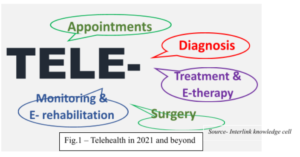Physical appointments and even the referrals have been declined due to pandemic as there was no active and physical consulting going on. This is leading to increased adaptiveness toward Telehealth platforms which are emerging at a rapid pace in various hospitals and private clinics, enabling the hospitals to expand their services in multiple and beneficial ways.
Tele-ICUs are one of the biggest examples arising in today’s scenario, where number of hospitals placed at distant from one another, are able to communicate with hospital critical care units and achieve real-time services via technological advancements.
Surging incidences of infectious disease is the factor which shaping patients’ mindset in such a way that they obliged to choose such virtual platform which making hospitals to rethink about their old practice and service models. Although, quite a good number of healthcare systems have become well-equipped with this new platform, many are still struggling to maintain their identity in this new normal of healthcare practices. Reasons might be many- lack of right awareness about the platform, over reliance on old-practice and service model, weak promotional tactics, etc.
So, following are the components of Telehealth through which hospitals are evolving and will continue to evolve in 2021 and beyond…
Tele-appointments-
They have turned out as an amazing option in pandemic. Tele-appointment is the facility which was earlier seen at the hospitals with huge infrastructure. But the situation is different and evolving nowadays. Many reasons associated with Covid fear are the fuelling factors for hospitals to adapt Tele-appointment technology even if the infrastructure is not huge.
Afterall everyone wants to be in the race!
Physicians who are carrying out telemedicine appointments, penetrating into their patient’s health without ever having to see them in the hospital. This is actively helping elders and patients with chronic conditions, making a big revolution in healthcare practices.
This technology is making impressive moves in providing services and giving entry to the medically inaccessible areas such as rural areas where hospital services are difficult to reach, which is ultimately propelling the establishment of telemedicine hospital centres in various rural areas.
Tele-diagnosis-
With increasing work load as hospitals turning into Covid centres, tele-diagnosis is reducing the burden on hospitals. Screening multiple patients is now possible while maintaining the treatment of others. Many technologies such as china’s virtual diagnosis of coronavirus using 5G network are rooting in hospitals giving relief to physicians, hospital staff and patients regarding possible spread of infection.
Nowadays, ESA-supported robotics technology making good moves in radiology examination. This system is already in force in Europe and Canada and examining heart, abdominal, pelvic, and urinary tract diseases remotely. Being on the video conferencing, radiologists and cardiologists are remotely moving robotic arms and adjusting settings to capture best possible images. These technologies are incredibly helpful while dealing with Corona-patients with other allied health issues.
Number of researches are going on to develop the best technology-based methods to provide virtual diagnosis, where necessary hardware installation in hospitals to make tele-diagnosis possible will always be the matter of concern for many under-developed hospitals.

Tele-treatments & surgeries-
Real time interaction with the specialists providing ease in getting proper and timely treatment and therapies making patients and hospitals more adaptive toward telehealth.
Many hospitals have adopted the digital way of prescribing i.e., E-prescribing which is constantly increasing and the market is its expected grow at a CAGR of 23.3%, will reach USD 3.3 billion by 2025. So ultimately, Tele-treatments are making the doors wide open for already emerging E-pharmacy sector.
Various E-therapies are becoming more and more promising in today’s scenario. Much impressive moves are seen in E-psychotherapy, where psychiatrists are directly engaging themselves in patients’ room virtually and taking deep insights about patients’ problems and recovery.
Although many delicate surgeries are performed aboard, Tele-health and technologies associated with it are helping patients and surgeons in the hospitals to be at their own county and operate the surgeries efficiently.
Hospitals having 5G network and robot-assisted equipment and hardware will provide fast data transfers with little to no latency in the procedure giving excellent outputs while performing virtual surgeries.
Tele-monitoring & E-rehabilitation-
Post-surgery monitoring is always important when patient is discharged, hospitals are now evolving in the field of post-surgery consultation. Tele-monitoring provides a better option to virtually meet the physician while lying on to the bed at home, without struggling with paining stiches on the way to hospital. Elderly patients or patients with decreased mobility are extensively monitored with these technologies, helping them to recover much faster.
E-rehabilitation is much useful for patients with musculoskeletal conditions, multiple sclerosis, osteoarthritis, and recovery of motor function. Doctors in hospitals can monitor the movements of patients in Yoga and provide therapy in much effective manner, allowing patients to recover much faster than expected.

Although many hospitals are actively participating and adopting all these technologies, few are still not using it to its full potential. Many hospitals are well-equipped with all the technologies, hardware, infrastructure, etc but the factor which drags down the profit of some of the hospitals is- poor marketing of hospitals’ services.
Telehealth and technology related to it are the practice changing initiatives taken by many hospitals in 2020. It is a reality and every hospital need to accept and adopt it. Old hospital practice models will no longer remain superior. Years coming ahead are already showing the clear picture of technology-based services in every part of industry, healthcare is not an exception, hospital managements have to be ready to absorb and emit all these changes efficiently and wisely.
The article is written by Dr. Smarta and published by Asian hospital healthcare management in Jan’21
